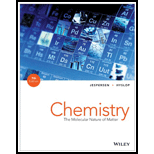
Concept explainers
Interpretation:
The IUPAC names of the given coordination complexes are to be determined
Concept Information:
Complex ions are the ions that are formed when a metal atom is at the center and other non-metallic molecules or ions surround it.
Ligands are the molecules or ions that are bonded to a metal ion with a coordinate covalent bond.
Coordination complexes are the complexes formed through coordinate covalent bonds between ligands and metals.
Usually, in
Anionic ligands change their name when naming a coordination complex, based on the suffix in their names. The ligands ending with –ide change to the suffix –o, those ending with –ite change to the suffix –ito, and the ligands ending with –ate change to the suffix –ato.
For naming a metallic ion, if the complex is anionic, then the name of the central metal ion in the coordinate complex ends with the suffix –ate and for neutral and cationic complexes, no changes are made to the name. The oxidation state of the metal is indicated by the roman numeral within the parenthesis following, without any space, the name of the metal.
Want to see the full answer?
Check out a sample textbook solution
Chapter 21 Solutions
Chemistry: The Molecular Nature of Matter
- Four different octahedral chromium coordination compounds exist that all have the same oxidation state for chromium and have H2O and Cl as the ligands and counterions. When 1 mole of each of the four compounds is dissolved in water, how many moles of silver chloride will precipitate upon addition of excess AgNO3?arrow_forwardPlatinum(II) forms many complexes, among them those with the following ligands. Give the formula and charge of each complex. (a) two ammonia molecules and one oxalate ion (C2O42-) (b) two ammonia molecules, one thiocyanate ion (SCN-), and one bromide ion (c) one ethylenediamine molecule and two nitrite ionsarrow_forward
 Chemistry: Principles and ReactionsChemistryISBN:9781305079373Author:William L. Masterton, Cecile N. HurleyPublisher:Cengage Learning
Chemistry: Principles and ReactionsChemistryISBN:9781305079373Author:William L. Masterton, Cecile N. HurleyPublisher:Cengage Learning Chemistry: The Molecular ScienceChemistryISBN:9781285199047Author:John W. Moore, Conrad L. StanitskiPublisher:Cengage Learning
Chemistry: The Molecular ScienceChemistryISBN:9781285199047Author:John W. Moore, Conrad L. StanitskiPublisher:Cengage Learning Chemistry: Principles and PracticeChemistryISBN:9780534420123Author:Daniel L. Reger, Scott R. Goode, David W. Ball, Edward MercerPublisher:Cengage Learning
Chemistry: Principles and PracticeChemistryISBN:9780534420123Author:Daniel L. Reger, Scott R. Goode, David W. Ball, Edward MercerPublisher:Cengage Learning Chemistry: An Atoms First ApproachChemistryISBN:9781305079243Author:Steven S. Zumdahl, Susan A. ZumdahlPublisher:Cengage Learning
Chemistry: An Atoms First ApproachChemistryISBN:9781305079243Author:Steven S. Zumdahl, Susan A. ZumdahlPublisher:Cengage Learning
 ChemistryChemistryISBN:9781305957404Author:Steven S. Zumdahl, Susan A. Zumdahl, Donald J. DeCostePublisher:Cengage Learning
ChemistryChemistryISBN:9781305957404Author:Steven S. Zumdahl, Susan A. Zumdahl, Donald J. DeCostePublisher:Cengage Learning





